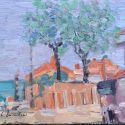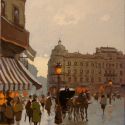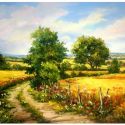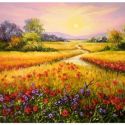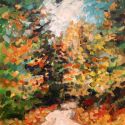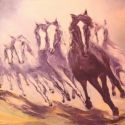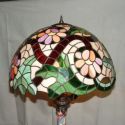Born on 30 August 1748: Jacques~Louis David, French Neoclassical painter, specialized in Historical Subjects, who died on 29 December 1825.
David, innovator of the Neoclassical Movement, was born in Paris in a wealthy Third Estate family. When he was 9, his father died in a duel, and his mother put him in the hands of his uncles' to bring him up. David went to many schools throughout his early life, but never did real well because he was always busy drawing during class.
At sixteen Louis David went to "painting school" at the Académie Royale. He had a certain interest in painting historical paintings and portraits. However, in his early career he produced many paintings of Greek and Roman mythology. He had his first training from Boucher, a distant relative, but Boucher realized that their temperaments were opposed and sent David to Vien. In 1776 he went to Italy with the latter, Vien having been appointed director of the French Academy at Rome, David having won the Prix de Rome in 1774.
While in Italy, David became influenced by classical art, which soon evolved in his own neoclassical style and came into contact with the initiators of the new Classical revival, including Gavin Hamilton. In 1780 he returned to Paris and in the 1780s his position was firmly established as the embodiment of the social and moral reaction from the frivolity of the Rococo. After many failures in the Academy's competition, David finally developed his own style and originality and his newly created neoclassical style was also used to represent contemporary political issues. He joined the Primitives, a group of other neoclassicists in Europe, and his work became the model for the next twenty years, received with acclamation by critics and public alike. His uncompromising subordination of color to drawing and his economy of statement were in keeping with the new severity of taste. His themes gave expression to the new cult of the civic virtues of stoical self-sacrifice, devotion to duty, honesty, and austerity. Seldom have paintings so completely typified the sentiment of an age as David's The Oath of the Horatii (1784), Brutus and his Dead Sons (1789), and The Death of Socrates (1787).
David was in active sympathy with the Revolution, becoming a Deputy and voting for the execution of Louis XVI. During the course of his involvement in the French Revolution (1789-1799), he reverted to a realistic style. He was an extremist and was a member of the Montagnards, the same group Robespierre, Marat, and Danton are associated with. Through his involvement in the Revolution and the Montagnards, Jacques-Louis David is remembered for many things other than his paintings, and not all of them are positive. He was one of the founders of France's museums, including the Louvre. He also a deputy to the National Convention and on the Committee of General Security and put more than 300 people to death. But his position was unchallenged as the painter of the Revolution. His three paintings of 'martyrs of the Revolution', though conceived as portraits, raised portraiture into the domain of universal tragedy, the most famous being The Death of Marat (1793) After the fall of Robespierre (1794), however, he was imprisoned, but was released on demand of the public, his students and on the plea of his wife, who had previously divorced him because of his Revolutionary sympathies (she was a royalist). They were remarried in 1796, and David's Intervention of the Sabine Women (1799), begun while he was in prison, is said to have been painted to honor her, its theme being one of love prevailing over conflict. It was also interpreted at the time, however, as a plea for conciliation in the civil strife that France suffered after the Revolution and it was the work that re-established David's fortunes and brought him to the attention of Napoléon.
In 1797 David met Napoléon Bonaparte. Napoléon asked David to dinner, and David accepted. David asked to paint him, and Napoléon agreed, but David was allowed only one sitting with Napoléon and only got his face sketched. David became an admirer of Napoléon. In 1800, David became Napoléon's official painter and remained at that position until 1815 when Napoléon's Empire collapsed. David became an ardent supporter of Napoléon and retained under him the dominant social and artistic position which he had previously held. Between 1802 and 1807 he painted a series of pictures glorifying the exploits of the Emperor, among them the enormous Sacre de Napoléon I (1807). These works show a change both in technique and in feeling from the earlier Republican works. The cold colors and severe compositions of the heroic paintings gave place to a new feeling for pageantry which had something in common with Romantic painting, although he always remained opposed to the Romantic school.
After Napoléon’s downfall, David went into exile in Brussels, Belgium, and began painting mythological subjects again. His work weakened as the possibility of exerting a moral and social influence receded. (Until recently his late history paintings were generally scorned by critics, but their sensuous qualities are now winning them a more appreciative audience.) He continued to be an outstanding portraitist, but he never surpassed such earlier achievements as the great Napoléon Crossing the Alps (1800, four versions) or the cooly erotic Madame Récamier (1800). David's work had a resounding influence on the development of French - and indeed European - painting, in itself and through his many students.



